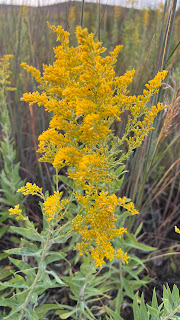I hope you've been enjoying the series of prairie wildflowers I've added to the blog in the past week or so. However, I would be remiss if I didn't also illustrate that the wildflowers aren't the only blooms or color on the prairie right now. Some of the prairie grasses also bloom at this time and there are always forbs with some nice foliage contrast:

These long spires are the flowers of the appropriately-named "June Grass" (
Koeleria macrantha). June Grass is a perennial in the Poas family and grows 18-24 inches tall, pushing these green-white heads above the surrounding Bluestem and Indian Grass during this month, but then they'll be overshadowed later by those taller grasses. Named for a German botanist of the 18th century, Ludwig Koeler, June Grass grows in sporadic tufts over the native prairie grass and blends in with the airy white inflorescence's of PrairieYarrow and Philadelphia Fleabane.

Another brownly-blooming denizen of the prairie right now is Texas Bluegrass (
Poa arachnifera). This dioecious grass chooses whatever sex of flower it wants to display and gets right down to it in the early summer. The species name refers to the long white hairs of the spikelets which are said to resemble a spider web. I don't see the resemblance, myself.

Unfortunately or fortunately, my surrounding prairie is blessed with a nice silvery-foliaged sage that I could also argue should be viewed as a prolific weed. White Sage (
Artemsia ludoviciana) is everywhere, both over the prairie and in my mown prairie lawn, where it stands out with a definite weedy look. I once cultivated a clump in my front landscaping where I thought it would make a nice 2-3 foot foliage contrast plant, only to realize that it spreads quickly by rhizomes and is fairly invasive. The flowers are also not very noticeable in the border, so my advice is to just keep this one on the prairie. I'm still pulling it up from among the Monarda and roses. It is also known as sagewort or wormwood, both alternative common names that are closer to the true nature of the plant. Native Americans used the aromatic leaves of this plant for everything from toilet paper to underarm deodorant to mosquito repellent, so maybe the best use of the plant is to keep pulling it up anyway.

But enough of prairie plants without flowers. I know that some of you must have been wondering why I hadn't posted pictures of the native prairie echinaceas, but the truth is that they hadn't bloomed until just the past couple of days. If I have identified the species correctly, this is Black-Sampson Echinacea (Echinacea angustifolia). I'm not a botanist but the other Echinacea in the area, Echinacea pallida, has longer petals and is a little paler-pink to my eyes. Everyone knows about the pain-reducing compounds in Echinacea, including the Native Americans who used the plant to treat toothaches, burns and sore throats, but what you may not know is that Echinacea is the Greek word for "hedgehog", transferred to the genus here because of the spiny bracts of the flowers. The taproot of this drought-resistant plant can grow down 5 to 8 feet, so you can forget about transplanting this one from the prairie into your garden.
For the time being, that's about the end of the June-blooming wildflowers here on the prairie, although I noticed that the prairie thistles are just starting to open up. When they get rolling, I'll come back with their stickery display. But tomorrow, a special treat for all you native wildflower lovers before Garden Musings moves back on Sunday to my cultivated garden for blogging material! For one thing, I think it's high time that I told the truth about Sally Holmes so I'm dying to get to that already-conceived post.

.jpg) So consider this a short tour of the ditches alongside the road. Of course, this time of year, Goldenrod is everywhere. My plant identification is suspect as always, especially here given the number of native Goldenrods, but I believe the photos above and left are of Tall Goldenrod, Solidago altissima, although it could be Canadian Goldenrod, the former being a subspecies of the latter.
So consider this a short tour of the ditches alongside the road. Of course, this time of year, Goldenrod is everywhere. My plant identification is suspect as always, especially here given the number of native Goldenrods, but I believe the photos above and left are of Tall Goldenrod, Solidago altissima, although it could be Canadian Goldenrod, the former being a subspecies of the latter..jpg) There is a lot of White Sage, Artemsia ludoviciana. on the walk, everywhere in the adjacent prairie, its hairy-gray leaves befitting a plant adapted to drought and grazing.
There is a lot of White Sage, Artemsia ludoviciana. on the walk, everywhere in the adjacent prairie, its hairy-gray leaves befitting a plant adapted to drought and grazing..jpg) Nearly last, but certainly not least, clumps of the the most "garden-worthy" of the prairie plants, Dotted Gayfeather, Liatris punctata, "dots" the prairie with low light purple spires. Butterflies love this plant, and often are above it in a swarm.
Nearly last, but certainly not least, clumps of the the most "garden-worthy" of the prairie plants, Dotted Gayfeather, Liatris punctata, "dots" the prairie with low light purple spires. Butterflies love this plant, and often are above it in a swarm. .jpg)
.jpg)
.jpg)
.jpg)
.jpg)
.jpg)
.jpg)
.jpg)
.jpg)
.jpg)



